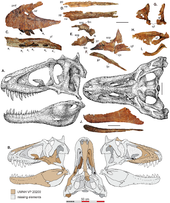Lythronax
| Lythronax Temporal range: Late Cretaceous,
| |
|---|---|

| |
| Skeletal reconstruction of Lythronax (A) and Teratophoneus (B) | |
| Scientific classification | |
| Domain: | Eukaryota |
| Kingdom: | Animalia |
| Phylum: | Chordata |
| Clade: | Dinosauria |
| Clade: | Saurischia |
| Clade: | Theropoda |
| Family: | †Tyrannosauridae |
| Clade: | †Teratophoneini |
| Genus: | †Lythronax Loewen et al., 2013 |
| Type species | |
| †Lythronax argestes Loewen et al., 2013
| |
Lythronax ("king of gore", from Greek words lythron meaning "gore" and anax meaning "king") is an extinct genus of tyrannosaurid theropod dinosaur which lived around 80 million years ago in what is now southern Utah. L. argestes is the oldest known tyrannosaurid based on its stratigraphic position.[1]
Description

Lythronax is known from a partial skeleton and its diagnostic features include a reduced alveoli count in the maxilla, a concave lateral margin of the dentary, its tall cervical neural spine and a broad caudal portion of the skull. The holotype specimen consists of the right maxilla, both nasal bones, the right frontal, the left jugal, the left quadrate, the right laterosphenoid, the right palatine, the left dentary, the left splenial, the left surangular, the left prearticular, a dorsal rib, a caudal chevron, both pubic bones, the left tibia and fibula, and left metatarsals II and IV. Based on the assemblage, the fossils are considered to have come from one individual, which was an adult.[1]
Comparisons to its close relatives suggest that Lythronax would have been about 8 m (26.2 ft) long, with a weight of around 2.5 tonnes (5,500 lb) and had a large skull filled with sharp teeth.[2] The rostrum is comparatively short, since it makes up less than two thirds of the total skull length. The whole skull is very broad, it's 0.4 times as wide as long. Overall, the skull is morphologically most similar to that of Tyrannosaurus and Tarbosaurus. Its robust maxilla possessed a heterodont dentition, as its first five teeth are a lot larger than the other six. Like other tyrannosaurids, Lythronax has large, distally expanded pubic boot which is approximately 60% the length of the pubic bone. The postcranial morphology is similar to that of other tyrannosaurids.[1]
Discovery
Lythronax is known from the most complete tyrannosaurid specimen discovered from southern Laramidia. This specimen is housed in the collection of Natural History Museum of Utah in Salt Lake City, Utah. The holotype specimen UMNH VP 20200 was recovered in the UMNH VP 1501 locality of the Wahweap Formation at Grand Staircase-Escalante National Monument (GSENM), in Kane County, southern Utah. It was discovered in 2009 and collected from the lower part of the middle member of this formation in terrestrial sediments that were radioisotopically dated as being approximately 80 million years old.[3][4] Based on its stratigraphic position, L. argestes is the oldest tyrannosaurid dinosaur discovered so far.[1]
Paleobiology
Vision

Lythronax had a short, narrow snout and a wide skull back, with eyes oriented toward the front. This anatomy would have given the dinosaur overlapping vision, allowing it to perceive depth. Tyrannosaurus had a similar anatomy, study researcher Loewen said in a statement.[5]
Feeding
That shape of the skull is linked to how they would bite and by extension probably linked to both feeding and killing, so it suggests Lythronax had a style rather different to other tyrannosaurs of its time. The positions of some of the other tyrannosaurs have moved quite considerably and suggests a very different pattern of evolution to what has previously been considered.[6]
It has been stated that its teeth aren’t quite as big, but still sort of resemble banana-shaped meat cleavers. Its teeth are serrated like a steak knife, but also quite beefy. It was observed that they weren’t just for slicing meat, they were for inflicting damage and crushing bone.[7]
Classification
Lythronax argestes belongs to the family Tyrannosauridae, a family of large-bodied coelurosaurs, with most genera known from North America and Asia. A detailed phylogenetic analysis, based on 303 cranial and 198 postcranial features, places it and Teratophoneus within Tyrannosaurinae. Lythronax is a sister taxon of a clade consisting of the Maastrichtian taxa Tarbosaurus and Tyrannosaurus and the late Campanian Zhuchengtyrannus.[1]
Below is the cladogram by Loewen et al. in 2013.[1]
| Tyrannosauridae |
| ||||||||||||||||||||||||
Previously, palaeontologists had thought there were multiple exchanges of tyrannosauroids between Asia and North America with various forms moving between the continents via what is now Alaska and the Bering Strait into northern Russia. The new work, however, suggests that almost all of the Asian tyrannosauroids were part of one evolutionary lineage. There were separate evolutionary radiations in North America of northern and southern tyrannosaurids, with Lythronax part of the southern group.[2]
References
- ^ a b c d e f Attention: This template ({{cite doi}}) is deprecated. To cite the publication identified by doi:10.1371/journal.pone.0079420, please use {{cite journal}} (if it was published in a bona fide academic journal, otherwise {{cite report}} with
|doi=10.1371/journal.pone.0079420instead. - ^ a b "T. rex gets a new relative: Lythronax argestes, gore king of the south". Walking with dinosaurs. David Hone. Retrieved 6 November 2013.
- ^ McCombs, Brady (6 November 2013). "New dinosaur that predates T. rex found in Utah". AP News. Retrieved 8 November 2013.
- ^ Jha, Alok; Hone, Dr David (6 November 2013). "'King of Gore' joins T. rex family tree". The Guardian. Retrieved 6 November 2013.
- ^ "New Dinosaur Species, Lythronax Argestes, Discovered In Utah". LiveScience. Stephanie Pappas. Retrieved 8 November 2013.
- ^ "Lythronax argestes: a new tyrant and the spread of the tyrannosaurs". the Guardian. Retrieved 8 November 2013.
- ^ "King of gore dinosaur was the 'bad grandpa' of tyrannosaurs". Los Angeles Times. Geoffrey Mohan. Retrieved 8 November 2013.
